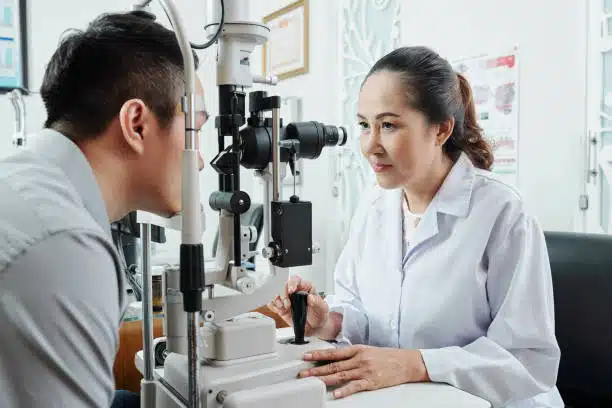Exactly How an Eye Doctor Can Change Your Vision Health in Chino
Exactly How an Eye Doctor Can Change Your Vision Health in Chino
Blog Article
Discovering the current Technological Innovations in Optometry and What They Mean for Optometrists
From the precision of Optical Coherence Tomography to the nuanced understandings provided by AI-driven diagnostic devices, these innovations are setting brand-new criteria in client analysis and treatment. As these innovations penetrate the method, optometrists are encountered with the difficulty of embracing these tools to enhance patient end results.
Innovations in Diagnostic Devices
Advancing the area of optometry, innovations in diagnostic devices have transformed the method eye treatment experts analyze and diagnose visual impairments and eye problems. The previous decade has actually experienced substantial technical improvements, allowing more detailed and accurate evaluations. Optical Comprehensibility Tomography (OCT), as an example, offers high-resolution cross-sectional photos of the retina, enabling for the very early discovery of conditions such as glaucoma and age-related macular deterioration. This non-invasive imaging method has actually come to be indispensable in contemporary optometric technique.
An additional key technology is the intro of innovative corneal topography systems, which map the surface curvature of the cornea with accuracy. These tools are especially advantageous for suitable call lenses and detecting corneal problems. Additionally, electronic retinal imaging has actually transformed typical ophthalmoscopy, offering thorough, panoramic sights of the retina that promote complete aesthetic evaluations.
The development of wavefront aberrometry has likewise been crucial, making it possible for the evaluation of refractive errors with unequaled precision (Eye Doctor). This innovation aids in tailoring rehabilitative lenses and enhancing surgical outcomes for refractive surgeries. Jointly, these analysis advancements empower optometrists to provide premium individual care, making sure early treatment and customized treatment methods, inevitably enhancing visual health results
AI in Individual Management
Building on the foundation of cutting-edge diagnostic tools, the incorporation of expert system (AI) in patient monitoring stands for a transformative leap for optometry. AI systems are increasingly employed to boost effectiveness, precision, and personalization in person treatment. By examining large amounts of information, AI can identify patterns and anticipate prospective eye conditions, enabling eye doctors to tailor interventions a lot more successfully. This ability is critical in managing persistent eye conditions such as glaucoma and diabetic retinopathy, where very early detection and continual tracking are key.
Furthermore, AI-driven platforms help with streamlined patient interactions and management procedures. Automated organizing, digital appointments, and customized follow-up strategies not just enhance person contentment however also maximize time administration for experts. These systems can triage individuals based upon the seriousness of their problems, guaranteeing that those in essential requirement obtain punctual attention.
In addition, AI enhances decision-making by supplying eye doctors with evidence-based referrals and therapy pathways. By integrating data from digital health documents, AI devices supply understandings that inform scientific choices, reducing the danger of mistakes and boosting patient outcomes. As AI proceeds to develop, its function in individual monitoring will likely expand, improving the landscape of optometric care.
Breakthroughs in Retinal Imaging
In the realm of optometry, retinal imaging has actually experienced remarkable technical developments that are improving diagnostic abilities and person care. Innovations such as Optical Coherence Tomography (OCT) and fundus photography have revolutionized exactly how optometrists imagine and assess the retina. OCT, in certain, gives high-resolution, cross-sectional pictures of More Help the retina, permitting the thorough examination of its layers. This capability is indispensable for early detection and monitoring of problems like glaucoma, diabetic person retinopathy, and age-related macular degeneration.
Boosted imaging methods like OCT angiography are additional refining analysis precision. Eye Doctor Optometrist. Such developments facilitate the identification of min retinal adjustments that can symbolize condition progression.
Moreover, innovations in man-made knowledge are increasing retinal imaging by making it possible for automated analysis of big datasets. These systems assist optometrists in recognizing patterns a measure of pathology, thereby enhancing analysis precision and performance. Collectively, these technologies are changing retinal imaging right into a keystone of modern-day eye treatment, improving outcomes and expanding therapeutic possibilities.
Teleoptometry's Expanding Duty
Teleoptometry is progressively ending up being a crucial component of eye care, driven by advancements in data and analysis devices. As optometry embraces digital improvement, teleoptometry facilitates remote assessments, allowing optometrists to expand their solutions past typical borders. This is especially beneficial in rural and underserved locations where access to specialized eye treatment is typically restricted. By leveraging high-resolution video conferencing and advanced retinal imaging, optometrists can perform extensive eye exams from afar, making certain prompt medical diagnosis and therapy.
The combination of man-made intelligence (AI) further boosts teleoptometry, allowing the evaluation of visual information and helping in the discovery of ocular conditions such as glaucoma and diabetic person retinopathy. AI-powered algorithms can swiftly interpret intricate imaging data, providing eye doctors with useful insights that boost medical decision-making.
Moreover, teleoptometry supports connection of care with smooth combination with digital health and wellness documents (EHRs), allowing optometrists to maintain detailed patient backgrounds. When seeking advice from with blog various specialists., this guarantees that people receive consistent and individualized care also.
Regardless of these advantages, obstacles remain, including making sure information safety and security and click here to find out more handling person assumptions. Nevertheless, teleoptometry represents a substantial stride towards more available, reliable, and patient-centered eye treatment. As technology progresses, its role is poised to broaden better.

Future Trends in Eye Care
A myriad of innovative fads is readied to reshape the future of eye treatment, driven by technical improvements and the progressing requirements of people. One substantial trend is the combination of man-made intelligence (AI) in diagnostics, which promises to boost the accuracy and performance of eye exams. AI formulas can evaluate substantial amounts of information from retinal photos, potentially spotting conditions like diabetic person retinopathy and glaucoma earlier than standard methods.
Additionally, tailored medication is acquiring grip in optometry, with genetic testing informing personalized treatment strategies. This technique intends to optimize person end results by customizing interventions to individual hereditary profiles. Wearable innovation, such as clever get in touch with lenses, is likewise imminent, using real-time monitoring of intraocular pressure or glucose levels, hence supplying constant understandings into systemic and ocular health and wellness.
The adoption of enhanced reality (AR) and online reality (VR) in training and patient education is an additional emerging pattern. These innovations supply immersive experiences that can enhance understanding and abilities both for eye doctors and patients. As these patterns develop, eye doctors must stay abreast of technical innovations to offer sophisticated care, making sure improved individual end results and fulfillment in the vibrant landscape of eye care.
Conclusion

Jointly, these diagnostic improvements equip optometrists to supply superior person treatment, making certain early treatment and customized treatment techniques, inevitably enhancing aesthetic wellness results.

As these innovations proceed to evolve, optometrists need to adjust and incorporate them right into technique, inevitably enhancing operations efficiency and raising the requirement of eye care delivered to individuals.
Report this page